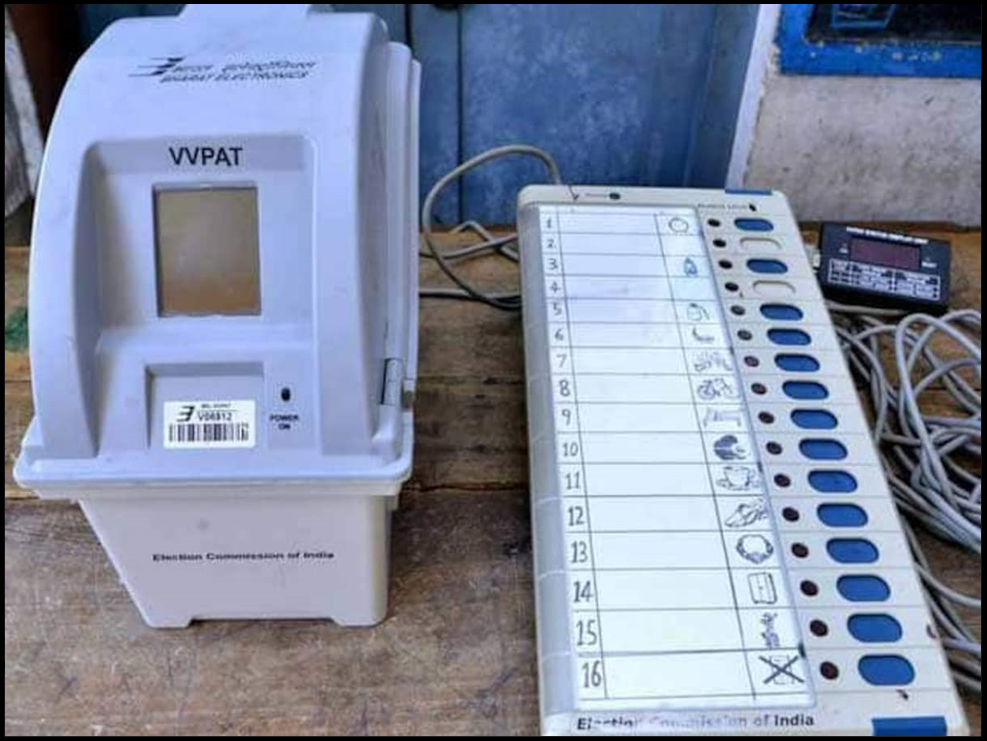DISAPPOINTMENT IN THE EVM-VVPAT CASE JUDGMENT
Syllabus:
- GS 2: Separation of powers between various organs dispute redressal mechanisms and institutions.
Focus:
- The Supreme Court of India has issued a notice to the Election Commission (EC) in response to a writ petition filed. The petition seeks a directive to mandatorily cross-verify the count in Electronic Voting Machines (EVMs) with votes recorded in Voter Verifiable Paper Audit Trail (VVPAT) slips.
Source: NDTV
The recent judgment on the EVM-VVPAT case by the Supreme Court has raised significant concerns regarding the adequacy of the sample size used for auditing electronic voting machines (EVMs). This decision has crucial implications for the integrity and reliability of electoral processes in India, highlighting issues of statistical soundness and transparency.
Overview of case
- The petitioner advocates for a comprehensive count of VVPAT slips in elections, differing from the current practice of verifying only five randomly selected EVMs through VVPAT paper slips.
- They contest the EC’s guideline mandating sequential VVPAT verification, citing undue delays caused by this approach.
- The petition suggests simultaneous VVPAT verification by deploying additional personnel for counting in each constituency, aiming to streamline the process within five to six hours.
- Highlighting the government’s substantial investment in purchasing VVPATs, the petitioner notes a significant gap between the number of VVPAT slips verified and the total number of VVPATs procured.
- Emphasizing concerns raised by experts regarding VVPATs and EVMs, they point out past instances of significant discrepancies between EVM and VVPAT vote counts.
- To address these concerns, the petition proposes allowing voters to physically deposit VVPAT slips into a ballot box or making the VVPAT machine’s glass transparent and extending the duration of the light for voters to witness the paper recording their votes.
Legal Implications:
- The Supreme Court has initiated legal proceedings by issuing a notice to the EC to consider the petitioner’s arguments and proposed solutions.
- The case’s outcome could significantly impact the transparency and integrity of elections in India, potentially altering the electoral process.
Uniform and Inadequate Sampling
- Inflexible Approach: The Supreme Court mandated a “one-size-fits-all” sample of 5 EVMs per Assembly Constituency without accounting for demographic and logistical variations.
- Ignorance of Statistical Norms: The mandated sample size does not adhere to established statistical sampling theories, risking the reliability of electoral audit processes.
- High Probability of Oversight: Statistical analysis suggests a 95% chance that this approach will miss detecting defective EVMs in Assembly Constituencies.
- Lack of Specificity: The judgment did not specify which ‘population’ of EVMs the sample size applies to, leading to potential inconsistencies in application.
- Ineffective Detection Capability: The selected sample size is too small to effectively detect discrepancies, undermining the purpose of VVPAT to ensure electoral integrity.
Transparency and Protocol Deficiencies
- Vague Legal Definitions: The Court and the Election Commission of India (ECI) failed to define critical terms such as ‘population’ and ‘defective EVM,’ creating ambiguity in the audit process.
- Omission of Detailed Procedures: The absence of specified next steps after detecting a defective EVM leaves the process open to subjective interpretation and potential misuse.
- ECI’s Non-disclosure: The ECI has not been transparent about its definitions and protocols, diminishing public trust in the electoral process.
- Lack of Expert Consultation: The Court did not seek or incorporate statistical expert opinions in finalizing the sample size, leading to a potentially flawed judgment.
- Unaddressed Mismatch Handling: There was no compelling directive for the ECI to publicly outline actions to be taken in case of mismatches, critical for ensuring electoral transparency.
Necessary Improvements for EVM-VVPAT Auditing
- Statistical Enhancement: Implement a system that uses a scientifically sound, statistically significant sample size capable of detecting mismatches with high accuracy.
- Tailored Sampling Strategy: Sample sizes should be adjusted based on constituency characteristics and historical data to better detect potential defects.
- Transparent Methodology: Clearly define all relevant terms and procedures in public documents to increase the accountability and transparency of the electoral process.
- Early Detection and Correction: Conduct audits at the start of the counting day to quickly identify and address any discrepancies.
- Engagement of Statistical Experts: Regularly involve statisticians in reviewing and updating audit protocols to reflect best practices and technological advancements
What is VVPAT?
Functionality:
Related Supreme Court Ruling:
|
Conclusion:
The Supreme Court’s ruling on the EVM-VVPAT audit process ultimately falls short in ensuring a robust and transparent electoral system. To uphold electoral integrity, it is imperative to adopt a scientifically validated, statistically sound audit mechanism, underpinned by clear and accountable procedures. This approach will not only enhance public trust but also strengthen the foundational democratic processes of the nation.
Source:The Hindu
Mains Practice Question:
Discuss the impact of this decision on the transparency and integrity of the electoral process in India. Suggest measures to improve the EVM-VVPAT audit system to ensure a more reliable and statistically sound electoral verification mechanism. (250 words)
Associated Articles:
https://universalinstitutions.com/supreme-court-to-address-vvpat-verification-pleas-on-april-16/
https://universalinstitutions.com/sc-affirms-credibility-of-voting-machine/




